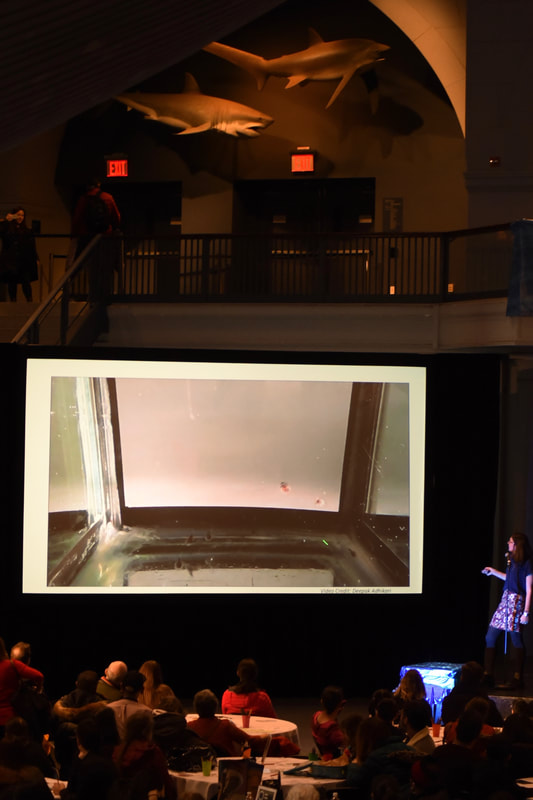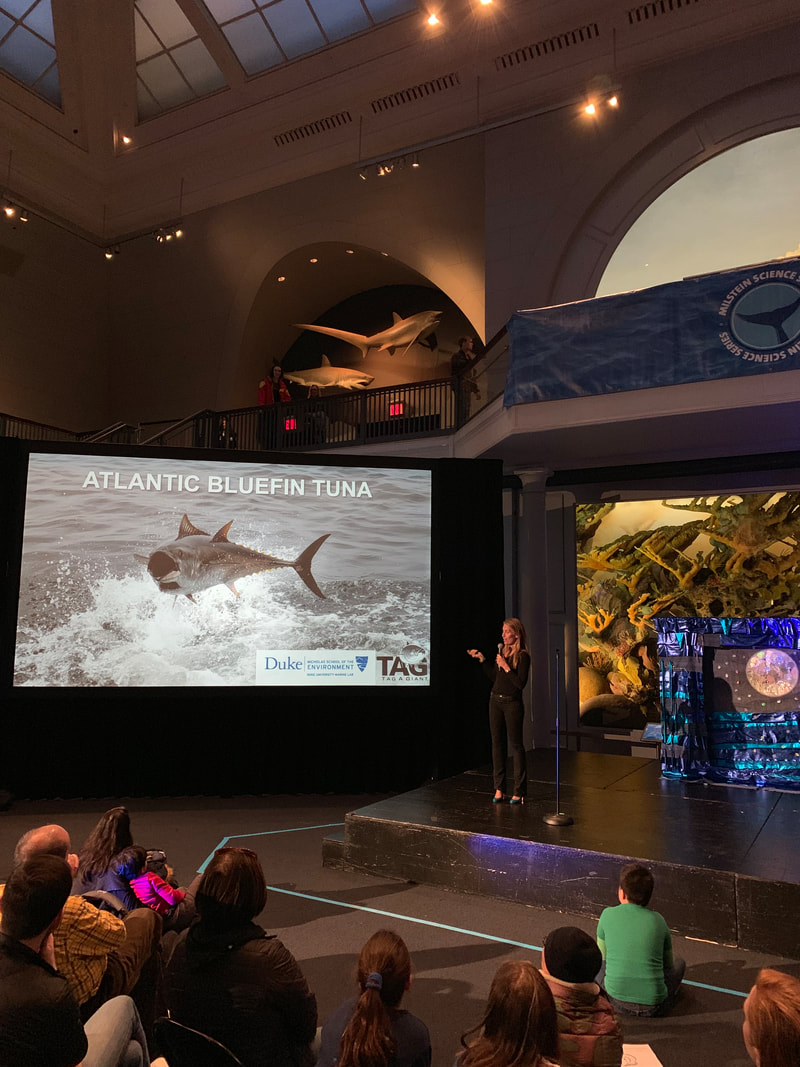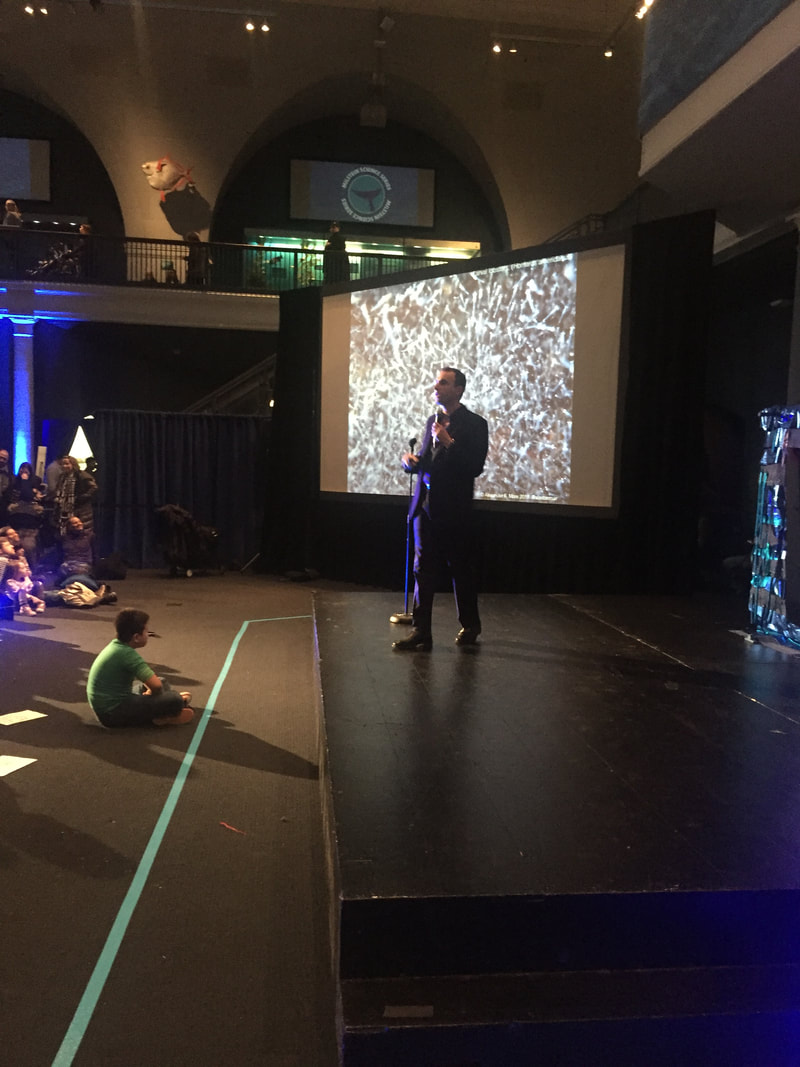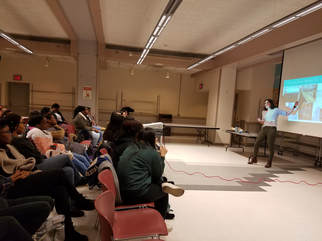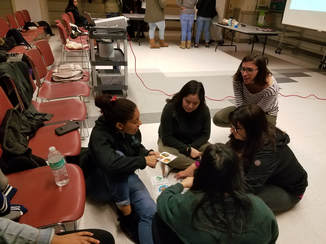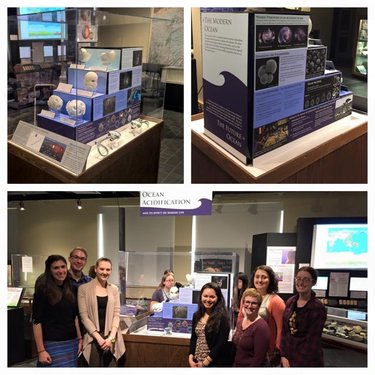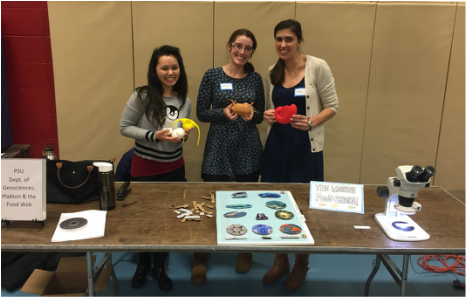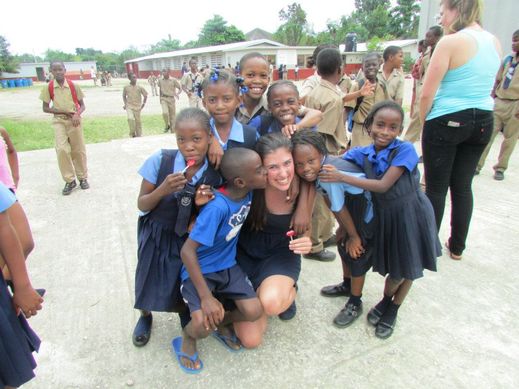Painting a mural at Discovery Bay All Ages School, Jamaica
Outreach
As a scientist, I think it is hugely important to be able to communicate your science on all levels. You should be able to talk to a leading scientist in your field one day and then explain what you talked to them about to the farmer who lives down the road the next day. Research becomes much more meaningful when we can explain its value to others.
Milstein Science Series at the American Museum of Natural History
I was invited to speak in the Milstein Science Series on Layers of the Ocean at the American Museum of Natural History in New York City. I talked about pteropods, their role in the food chain, their risk from ocean acidification, and discussed how reducing your carbon footprint can reduce the impact on the ocean. It was an amazing day, talking under the giant blue whale to over 5000 people that came though the event.
I spoke alongside two other incredible scientists: Gaelin Rosenwaks, a marine scientist, explorer, photographer and filmmaker, and Alex More, an Assistant Research Professor at Harvard's Climate Change Institute interested in climate change, population health and economics. They are both fantastic public speakers and science communicators. Check out their websites and follow them on twitter (Gaelin: website, twitter @GaelinGOExplore; Alex: website, twitter - @alastarmuir)
I spoke alongside two other incredible scientists: Gaelin Rosenwaks, a marine scientist, explorer, photographer and filmmaker, and Alex More, an Assistant Research Professor at Harvard's Climate Change Institute interested in climate change, population health and economics. They are both fantastic public speakers and science communicators. Check out their websites and follow them on twitter (Gaelin: website, twitter @GaelinGOExplore; Alex: website, twitter - @alastarmuir)
Me, talking about pteropods (Photo credit: A, More); Gaelin talking about tagging blue fin tuna (Photo credit: A.More); Alex talking about reduced numbers of juvenile lobsters off the coast of Maine.
Academy of Natural Sciences Blog
The Academy of Natural Sciences has a blog series on socially relevant topics. I was asked to write a blog on increasing ocean heat content and what the implications of that are going to be for society. Check it out here.
NOAA SOARCE WEBINAR - Spring, 2018
|
|
After meeting some NOAA representatives at the Ocean Sciences Meeting in Portland, I was asked to give a webinar about my research and outreach activities. The main audience for this webinar was educators and so I focused on explaining the methods I use in my research, highlighting some interesting results, and then talking about how the data from CT scanning can be used in outreach and education.
The webinar was recorded - give it a watch here! |
WINS Climate Change Workshop, Academy of Natural Sciences - Spring, 2018
|
The Women in Natural Sciences (WINS) program at the Academy of Natural Sciences is a free after-school enrichment program to introduce high school girls from the Philadelphia area to the natural sciences. I ran a session at their Change Workshop where we discussed what ocean acidification was, how it impacted pteropods, and what actions they could take on a day to day basis to reduce their impact on the environment. We also discussed what it was like to work as a women in science and what my daily routine looked like while living on a ship in the Southern Ocean!
|
Members night, Academy of Natural Sciences - Fall, 2017
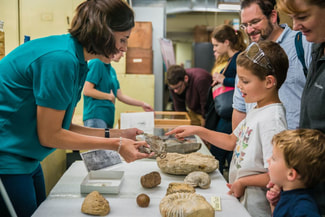
One advantage of working in a museum is that there are already events established which put scientists in touch with the general public. Members night is a chance for museum members to explore behind the scenes and see specimens which are usually stored in the collections. We ran a fossil table where members could touch specimens and try and work out what they were. We had ammonites, crinoids, and even a fossil crab!
If you think you'd like to see a different side of the museum, consider becoming a member.
If you think you'd like to see a different side of the museum, consider becoming a member.
Ocean Acidification Exhibit - Spring 2016
As part of a Museum Communication seminar in Fall 2015, a group of graduate students developed a museum exhibit for the Penn State Earth and Mineral Sciences Museum (check out this video which summaries the process).
The exhibit is focused on the role of calcareous plankton in the marine food chain and how this role will change if they are impacted by ocean acidification. The 3D prints used in the exhibit are based on CT scans collected for my PhD research.
Here is the news article about the museum exhibit launch.
The exhibit is focused on the role of calcareous plankton in the marine food chain and how this role will change if they are impacted by ocean acidification. The 3D prints used in the exhibit are based on CT scans collected for my PhD research.
Here is the news article about the museum exhibit launch.
|
The ocean acidification exhibit at Penn State with the team who designed it (from left to right): Rosie Oakes, Nick Holschuh, Kim Folke, Ashley Grey, Claire Cleveland, Judi Sclafani, and Heather Jones
|
|
3D printing
|
|
One advantage of using CT scanning in my research is that I can generate shape files from the data I collect which can then be 3D printed. We have a suite of Maker Bots in the Maker Commons at Penn State University. We don't get to choose the colours, but the prints come out looking pretty great!
Here is an interview I did about the 3D printing work we're doing. If you would like any of the shape files, I'm happy to share them - just shoot me an e-mail. |
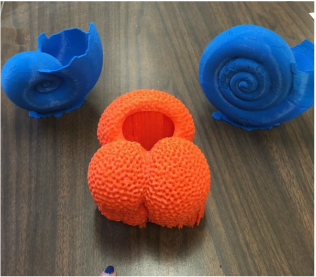
Here is an image of the 3D prints before they got spray painted!
We decided to have white prints in the exhibit because they will look like the actual shells of the organisms that live in the ocean.
I have shape files for these prints - please contact me if you would like them.
We decided to have white prints in the exhibit because they will look like the actual shells of the organisms that live in the ocean.
I have shape files for these prints - please contact me if you would like them.
Plankton and the marine food chain - February 2016
|
Easterly Park School held a science fair for K - 5th grade students. The Bralower lab group was invited to participate. We designed an activity to teach students about the importance of plankton in the marine food chain. This had three stages:
1) Looking at the shells of plankton under the microscope 2) Looking at englarged 3D prints of plankton to help show students what to look for under the microscope 3) Taking a step back and working with our food chain magnet board to make of flow of who eats whom in the ocean The activity worked well and we look forward to taking it to another event soon! |
Shake, Rattle and Rocks - January 2014 - 2016
As part of a continuing scheme between the Penn State Geosciences department and the local school, we invited local grade 5 classes into the department to learn about geology. In the paleoceanography lab we learnt about 'Ancient Oceans'. Students worked in groups to wash sediment samples taken from the deep ocean and then looked at the microfossils under the microscope. We then discussed what would happen to these organisms if atmospheric carbon dioxide levels continued to rise at the same rate as today.
Mural Painting, Discovery Bay All Ages School - February 2013
|
As part of a trip to Jamaica in February 2013 with the Penn State Geosciences department, I was lucky enough to be involved in an outreach project to the Discovery Bay All Ages School. We worked with students ranging from 4 - 14 years old and painted a mural of a coral reef ecosystem. The educational purpose of this was to see how much they knew about the reef ecosystem and explain why it should be taken care of. On a more social level, we were the first group of students who had been at the Discovery Bay Marine Lab who had wanted to interact with members of the community. It was a really great experience just chatting with the students, playing games and having my hair braided..!
This trip highlighted the importance of outreach on all scales and it's something I hope to do more of in the future. |
Our story even made the local news paper. Check it out here: http://www.centredaily.com/2013/04/20/3585323_meet-and-mural.html
Lionfish project, Discovery Bay, Jamaica - February 2013
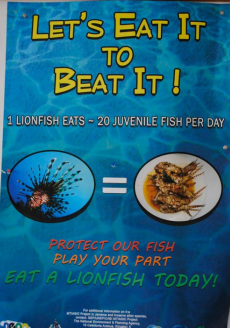
Whilst in Jamaica, we saw a fantastic example of outreach. There has been an influx of the non-native lionfish into Jamaica These fish consume vast amounts of small fish on the reef. They also have poisonous spines and therefore the local fishermen didn't want to catch them.
The Lionfish Research Team based at the Discovery Bay Marine Lab have been working on a national campaign, 'Let's Eat It to Beat It'. This has involved a series of outreach events such as training local fishermen how to remove the poisonous spines from the fish so that they are ready for sale, and teaching locals how to prepare the lionfish. They are also conducting research on the lionfish, the age and size they get to and they types of fish they like to consume.
The great thing about this project was the range of people who were being engaged in the campaign.
See this link for more information:
http://www.mona.uwi.edu/cms/dbml/Lionfish_Brochure.pdf
The Lionfish Research Team based at the Discovery Bay Marine Lab have been working on a national campaign, 'Let's Eat It to Beat It'. This has involved a series of outreach events such as training local fishermen how to remove the poisonous spines from the fish so that they are ready for sale, and teaching locals how to prepare the lionfish. They are also conducting research on the lionfish, the age and size they get to and they types of fish they like to consume.
The great thing about this project was the range of people who were being engaged in the campaign.
See this link for more information:
http://www.mona.uwi.edu/cms/dbml/Lionfish_Brochure.pdf
